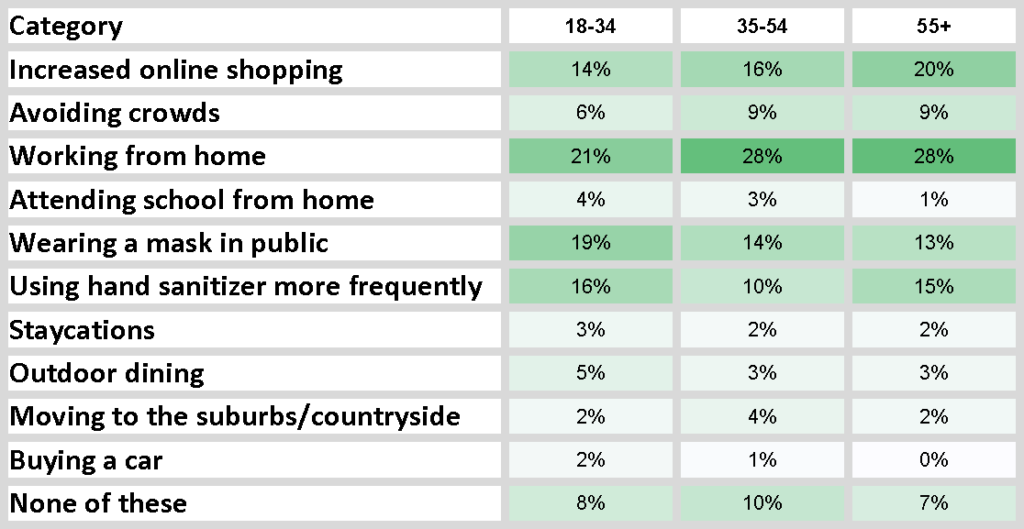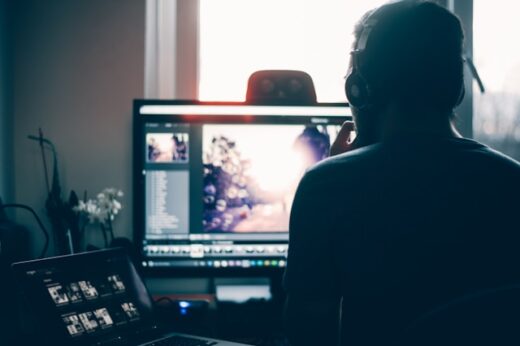Written by Michael LaPick
Healthcare Writer
We want to help you make educated healthcare decisions. While this post may have links to lead generation forms, this won’t influence our writing. We adhere to strict editorial standards to provide the most accurate and unbiased information.
Key Findings
- Asked when life may return to normal, the greatest number of Americans, 21%, said summer 2021.
- 40% of Americans said they already feel comfortable shopping indoors.
- 37% of Americans in households earning $80,000 or more identified working from home as the Covid-related trend most likely to continue, compared to just 20% with incomes under $40,000.
- 70% of Hispanics and 64% of Blacks are very or somewhat concerned over the possibility of another pandemic, but only 56% of Whites.
Pandemic-shocked Americans are divided over when life might return to normal.
Asked when they see life returning to as it was before the emergence of COVID-19, the greatest number of Americans, 21%, pointed to summer 2021.
But a total of 49% selected either fall 2021 (18%), winter 2021 (11%), or 2022 or later (20%).
13% said they never expect life to return to normal, but 11% were optimistic it would return to as it was before the pandemic as soon as spring 2021.
The figures emerged from a new poll by HealthCareInsider.com surveying American perceptions on the pandemic’s end.

We asked pollees when they’d feel comfortable resuming ten specific activities of normal life.
On not wearing a mask in public, the greatest number of Americans, 23%, said they wouldn’t feel comfortable till 2022 or later.
Pluralities of respondents also targeted 2022 or later for live entertainment (19%) and travel (18%).
But on family gatherings of more than 10, the largest number of Americans, 19%, are comfortable doing so in summer 2021.
Pluralities of respondents also favored summer 2021 for drinking and dining indoors (16%), working out in a gym (10%), shopping indoors (14%), and hugging someone close (14%).
Despite the known risks posed by the ten activities, large numbers of respondents said they’re already comfortable engaging in them.
40% said they already feel comfortable shopping indoors, followed by 30% who said hugging someone close, and 26% who said they’re already comfortable drinking and dining indoors.
Most Looked Forward to Activities
HealthCareInsider also asked participants which of the 10 activities they most look forward to resuming.
Not wearing a mask in public topped the list at 26% of all respondents.
Next up were family gatherings at 18%, followed by travel at 17%.
By age group, after mask wearing (20%), Millennials (18-34) are most looking forward to travel (19%).
Generation X (35-54) respondents are most eager (after not wearing a mask in public, at 25%) for travel (17%) and family gatherings (17%), while Baby Boomers (55+) are most looking forward (also after not wearing a mask in public – 31%) to family gatherings (20%).

COVID-19 has caused many Americans to put off big life events.
From a list provided, the greatest number of Americans, 53%, said they delayed holiday gatherings, followed by 51% for travel. 10% of respondents said they put off college or education, 8% having a wedding, and 6% having children.
Pandemic Trends Here to Stay
Asked which pandemic trends are most likely to continue after the pandemic, the greatest number of Americans, 26%, said working from home.
That was followed by increased online shopping at 17% and mask wearing at 15%.
But answers varied by income level.
37% of Americans who earned $80,000 or more said working from home was the trend most likely to continue, compared to 26% of those with $40,000-$80,000 in income and just 20% of respondents with incomes under $40,000.
COVID-19 has transformed life for many people, but respondents did not think some of the most salient COVID-19-related trends would last.
Just 8% of Americans think avoiding crowds is the trend most likely to be here to stay.
Only 4% said outdoor dining was the trend most likely to continue, and just 3% thought moving to the suburbs or countryside was most likely to be a durable phenomenon.

Racial Divide on Concern over a Future Pandemic
HealthCareInsider asked poll participants how concerned they are over the possibility of a future pandemic.
60% of Americans said they are very or somewhat concerned about the possibility of another pandemic.
But concern varied by race and gender.
70% of Hispanics and 64% of Blacks are very or somewhat concerned, but only 56% of Whites shared those sentiments.
By gender, 64% of women but only 55% of men said they are somewhat or very concerned about the possibility of another pandemic.
Preparing for the Next Pandemic
We asked Americans to select, from a list of six possible tactics, the one they saw as the most effective measure the federal government can do to contain a future pandemic.
The greatest number, 27%, said it should establish better testing and quarantine protocols.
Requiring people to wear a mask in public followed at 17%, and closing the borders of the U.S. at 16%.
Only 12% of respondents favored lockdowns (making people stay home and closing businesses) and just 6% each felt the best tactic was to either establish mandatory contact tracing for all citizens or let state governments take charge of the decision making.
We also asked pollees what the federal government should do to help hospitals prepare for future pandemics.
Among four categories, the greatest number, 56%, said the government should maintain adequate medical supply stockpiles.
Americans next want the government to do more to research and develop treatments, vaccines, testing, and contact tracing (50%), improve coordination among public health agencies (48%), and ensure better contact tracing using technology, even at the expense of people’s privacy (27%).
10% of respondents did not think the Federal government should do anything.
COVID-19 Shifted Opinions on Healthcare, Government and Essential Workers
HealthCareInsider also wanted to find out how the pandemic has shifted public opinion on workers and industries most involved in the response to COVID-19.
Essential workers came out on top. 68% of Americans said the pandemic made their opinion of essential workers more favorable.
That was followed by 50% for the healthcare delivery system, and 46% for teachers.
Respondents’ opinions of health insurance changed little, with 22% saying the pandemic made their opinion more favorable, and 25% saying it made their opinion of health insurance less favorable.
The government came out the worst in the survey.
Just 16% of Americans said the pandemic made their opinion of the government’s ability to handle a pandemic more favorable, with 54% of respondents saying it made their opinion of the government’s ability to do so less favorable.

Methodology
HealthCareInsider.com commissioned YouGov America to conduct the survey. All figures, unless otherwise stated, are from YouGov America. The total sample size was 1,411 adults. Fieldwork was undertaken December 14-15, 2020. The survey was carried out online. The figures have been weighted and are representative of all U.S. adults (aged 18+). The margin of error is 2.6% plus or minus.
Thank you for your feedback!







